Introduction to point of care recording
- Categories: Best Practice & Advice, Ebooks
Joe Webber
Share this article
Download your free ebook!
Don’t forget to grab your copy of our free Point of Care Recording ebook…
Contents
- Introduction
- What is point of care recording?
- The importance of point of care recording
- The benefits of point of care recording
- What is needed to achieve point of care recording?
- Using care management software for point of care recording
- Can I use a pen and paper for point of care recording?
- What does a good digital care records system look like?
- Using technology to help with point of care recording
- Top tips for point of care recording
Introduction
Care records are used to evidence personal data relating to the physical or mental health of an individual, as well as demonstrating the level of service offered by a care provider. In care homes and nursing homes, data can be recorded in various forms with a resident’s consent, including digital or handwritten documents and monitor charts. Regulators set out criteria to determine how well compliance requirements are being met, and look at historical healthcare records to determine if the care provider offers effective care and how organised, responsible and well-led their service is.
Point of care recording is an innovative method of documenting and managing care records which has revolutionised the care sector. Due to its person-centred approach it gives you the best chance of satisfying high standards of compliance. In addition to this, there are plenty of other benefits associated with point of care recording but many care businesses are still unaware of what those are. This ebook covers the fundamentals of the process and how it can be achieved, how technology plays a key role and top tips for implementing a system at your care setting.
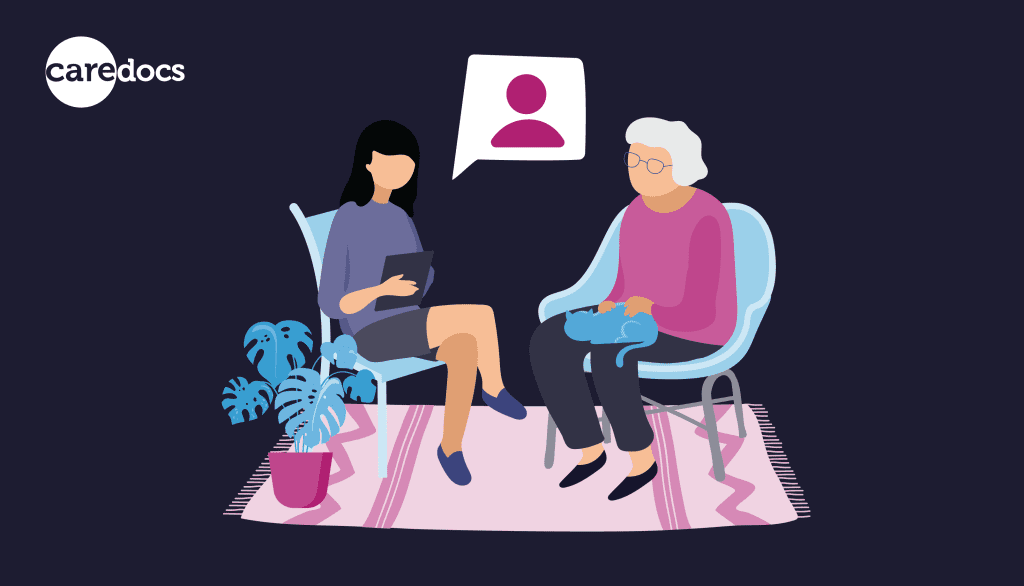
What is point of care recording?
Point of care recording is an accurate and efficient method of documenting health care records. It involves providing care, recording detailed information and storing the document in your business’s record system all while you are still with the resident. The records are normally created using a computer or remote device and then stored on a digital system. There are many benefits to working this way, for both the care provider and the resident. The ability to store care records digitally has been recognised by the NHS and several UK regulatory bodies as an important innovation in healthcare.
Point of care recording is an alternative to note-writing at the point of care and creating official records at a later time, which has been a traditional method used by care providers for many years. Although making notes is still an essential part of providing daily care, there are several disadvantages to relying on handwritten notes for record keeping. In contrast to using paper, the advantages of point of care recording have only been growing as technology becomes smarter. Interest and uptake of digital record keeping has seen a huge increase in recent years due to the rise of affordable products for care businesses and a push from the Department of Health and Social Care to highlight the benefits which technology can bring to a care environment.
The importance of point of care recording
Keeping records of the care you deliver is not only a regulatory requirement, it’s essential for providing the best possible service. By storing detailed records of treatment, personal preferences, moods, actions and events, you can improve the health of residents and the efficiency of your business, just by having a written reference to look back on and learn from. Point of care recording gives you the best opportunity to create accurate and detailed documentation, helping both your residents and your business to succeed.
With so much information to manage, it’s important to have a proper system in place so nothing is accidentally missed which may cause harm to the resident later on. Many care homes now use care management software for this purpose – giving each staff member the ability to log, store and access vast amounts of data with the least amount of effort. With a reliable point of care recording system in place, the logging and storing processes are connected to maximise productivity and give you more time to spend with residents.
Maintaining a detailed and evolving care database allows staff to easily monitor resident treatment, goal progress and overall health. For example, digital charts and body maps are particularly helpful at displaying the effectiveness of medication because they communicate changes to residents’ vital signs over a period of time. Point of care recording updates your database in real time to help you analyse historic care records and make any improvements while you’re still with the resident to provide maximum comfort.
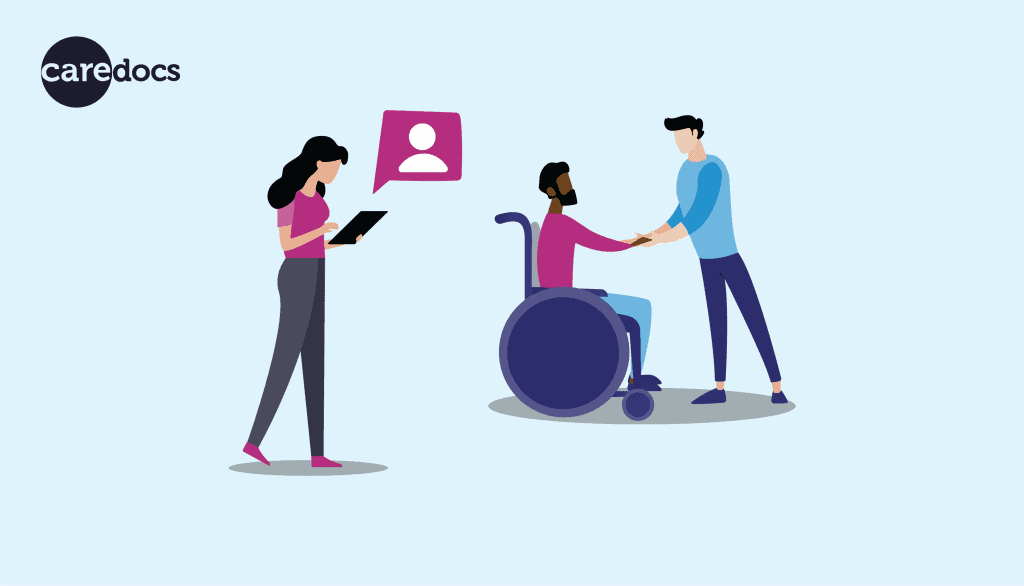
The benefits of point of care recording
Creating and storing records at the point of care is a very efficient process that saves you resource, energy and time that can be better spent on delivering outstanding service to your residents. With remote technology, you can offer your residents the chance to choose which location they would like to meet to have their care recorded, which increases their comfort and promotes independence. The additional one-on-one time you secure with residents in a comfortable environment can help relationships develop faster and increase the levels of trust. Building relationships is one of the most effective ways of encouraging more open discussions about health, resulting in highly accurate and impactful care records.
By using a single smart phone or tablet to record all your care, the inconvenience of carrying around bulky files to rummage through becomes a problem of the past. And because you’re connected to the internet, the work you log is stored instantly to your records system, saving the job of writing paper notes at the point of care and re-writing the same details for the record later in the day.
Entering the final information in real time increases accuracy and eliminates any risk of misinterpreting or forgetting key details of conversations or service. Many modern devices now have speech-to-text functionality, opening up a new way to record information. The ability to talk instead of type encourages more participation from the resident while offering an opportunity to hear what is being said. Speech-to-text recording is not yet widely used in care environments but it shows great potential for enhancing both transparency and efficiency. Once everyday tasks – like daily notes and chart entries – have been recorded they become available to all other staff who have access to the system. A synchronised system enables multiple staff to view the same information at different locations and provides more opportunity to communicate and collaborate across the business.
All major care regulators in the UK check records for evidence of effective care. Many individual factors are influential in helping you get the best outcome, but to comply with the highest standards, inspectors will look for evidence of a responsive and safe person-centred service where decisions are made in the best interests of the resident. Adopting a point of care recording system will give your staff the advantage of spending more one-on-one time with residents to learn more about their needs and make informed decisions regarding their care.
There are several more potential long-term benefits that you could start to notice after a short time. Digital point of care recording has proven to save money by simply improving efficiency across the business. One of these ways involves cutting costs by maximising your current resource’s potential. By removing excessive admin work and non-essential activities from the daily task list, you should see higher levels of productivity throughout the day. If your workforce is spending more time achieving the desired results, you might not need to hire that additional staff member to help out and pick up odd jobs.
Switching to a digital system could also help save money by reducing stationery costs, in addition to the effort and energy that goes into reordering and restocking the inventory. With less requirement for paper, you will be able to stop using physical filing systems, freeing up space which could be better put to use. If you’re conscious about your carbon footprint, switching from paper is a great way to reduce deliveries and waste.
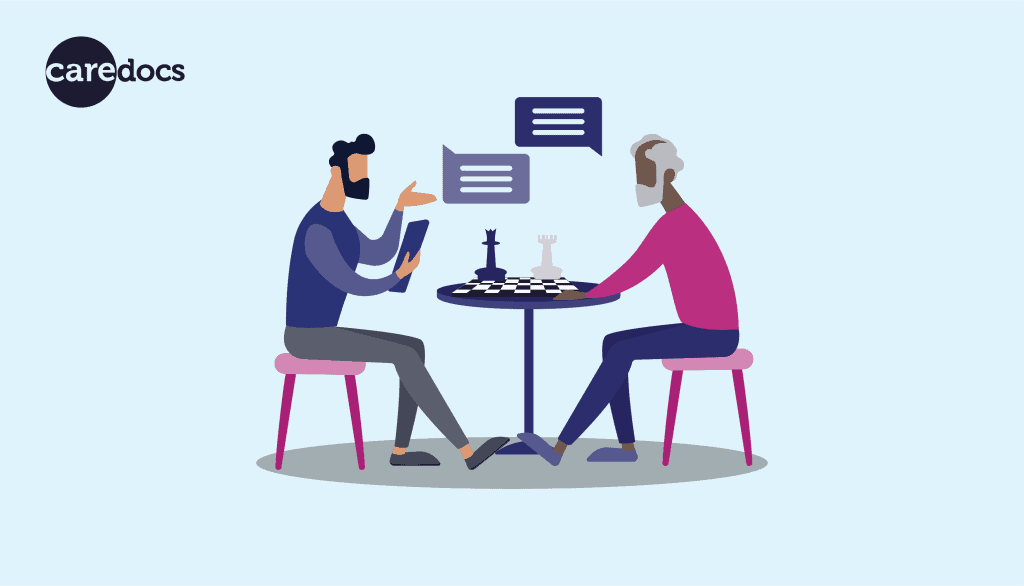
What is needed to achieve point of care recording?
Achieving point of care recording is dependent on having the right care management system, and more specifically, a flexible record keeping system. You will want to ensure that your records are detailed, accurate, final, stored and secure before leaving the point of care – and your systems will have to accommodate for this. By creating a finished record at the earliest opportunity and adding it straight to a resident’s care file, you will have peace of mind that the job is done to the highest standard while providing a comfortable and dedicated service. With the extra time you save from decreasing admin work, you naturally create more time that can be spent caring.
So what is realistically needed to make this happen? It’s important to remember first that point of care recording should decrease administrative work and not create extra steps. Coming up with your own electronic system which includes laptops and tablets with word processing software may sound like a simple solution, but there will still be admin elements that are challenging to get around. For example, if you use a laptop to record events or create care plans at the point of care, you would have to save the files in the correct folders and re-name them carefully to make it easier to search for later. Another thing to consider is how you will complete more visual documents like charts and body maps. Template documents may need to be designed, printed and scanned back into the system.
You will also need to have a shared and secure system that is easily available to your staff but restricted so only the correct records are accessible to the people who require them. An unsecure system that grants anyone access can result in breaches of GDPR and UK data laws. A system that involves many variables leaves opportunity for human error and inconsistency, especially when you have large numbers of staff trying to follow the same process. There are plenty of cloud-based file hosting services that you can choose from, like Dropbox and Google Drive but usually you will pay a monthly fee if you use over a certain amount of storage. However, another service that you can use as an alternative to the above is care management software, which is discussed in the next chapter.
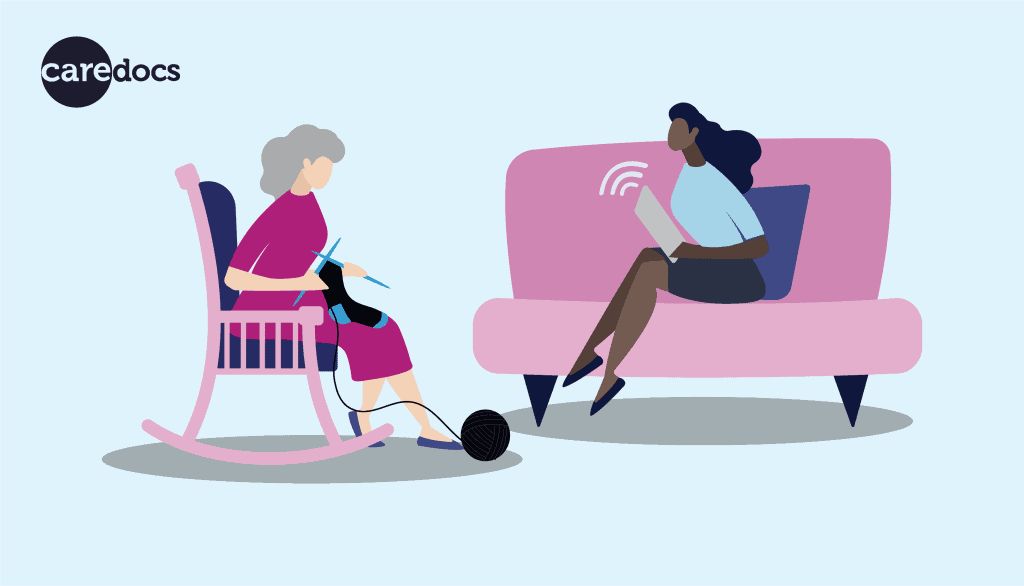
Using care management software for point of care recording
Digital care management systems, like CareDocs, are designed to be extremely efficient and eliminate all of the hard work of creating an electronic system yourself. You normally have to pay a monthly fee, but a good care management system will offer many other benefits in addition to point of care recording capability, allowing you to log daily note documents, complete care needs assessments and record chart entries either on a desktop computer or mobile device.
All records will instantly synchronise with the wider secure system as soon as they’ve been saved so other users with necessary permissions can find the records while maintaining GDPR compliance. The software should also give you the option to locate existing records easily at a later time to review or make improvements. If you decide to opt for a digital care management system then there are a couple of things to be aware of if you wish to achieve point of care recording.
Most modern systems are cloud-based and will require internet connection to work. One major advantage of having a cloud-based system is that your users can log records and communicate across different locations and devices, which helps create an extremely flexible working environment. For example, if a resident was unable to leave their room due to illness, you could use a compatible smart phone to record notes at the point of care, and another staff member in a different location could view the notes on their laptop and send an instant message offering guidance.
Alternatively, you could have a central computer system set-up in a comfortable private area and bring your residents there to discuss their care. Some software providers allow you to hire computer systems and mobile devices to support you with the process if you don’t have your own equipment. However, if you don’t have access to reliable internet at your setting then there are offline options available on the market that work by connecting multiple computers to your internal network so they are able to send data to each other in real time. As long as you can provide a great service that satisfies the fundamentals of point of care recording, it won’t matter if you have a cloud-based or local care management system.
Can I use a pen and paper for point of care recording?
Can care businesses that use paper systems, or scan paper records into a computer, achieve point of care recording with a pen and paper? Yes, in theory but it’s not advisable. This is because handwritten records will need to be stored immediately in your system making it an impractical approach when you’re trying to focus on giving your residents attention.
Trying to achieve point of care recording with paper involves a lot of admin work which defeats the objective. Ideally the process should be automated and there’s also the downside that the filing system is most-likely in an office environment and not a comfortable space. For a more efficient approach, an electronic record system should be considered to streamline to process and remove the task of physically storing or scanning the paper.
What does a good digital records system look like?
Each regulator has different standards for what makes a digital records system “good”. It’s worth checking directly with your regulatory body about what they like to see in an inspection scenario, however, many of the standards provided by the Care Quality Commission (CQC) apply across the UK.
As stated by the CQC, a “good records system delivers good outcomes from the point of view of people who use services”. This refers to both digital and paper records, but how those records are delivered in an inspection scenario may vary. In England, the best outcomes for residents have been from records that use “I statements” – essentially records that are worded from the perspective of a resident which anybody reading can relate to and understand. However, every resident is unique and records for individuals who don’t have the capacity to answer for themselves may be better worded in third-person if their requirements call for this approach.
In addition to the record being written in first-person (or third-person depending on the individual’s capacity), the following criteria will give you the best chance of complying with regulatory standards and achieving the best possible inspection results.
The record should be:
- Person-centred, describing what’s important to the resident, including needs, preferences and choices.
- Accessible, so the resident can see the information that’s important to them in a way they choose and can understand.
- Legible, so information is recorded clearly and can be easily read by the people who support the resident.
- Accurate, so information about the resident is correct and doesn’t contain errors.
- Complete, so there’s no relevant or essential information missing about the resident.
- Up to date, so it contains the latest relevant and essential information.
- Always available to the people who need to see them when they need them.
- Secure, so the privacy and confidentiality of the resident are protected.
- Helpful to the service that supports the resident, helping the provider to assess, monitor and minimise the risks to their health, safety and wellbeing and to help the resident keep improving.
All electronic records in England must also comply with:
- Regulation 17 Health and Social Care Act 2008 (Regulated Activities) Regulations 2014.
- Data protection legislation (including GDPR) requirements.
- Accessible Information Standard.
- Data Security and Protection Toolkit (where providers have access to NHS patient data and systems).
Source: https://www.cqc.org.uk/guidance-providers/regulations-enforcement/regulation-17-good-governance
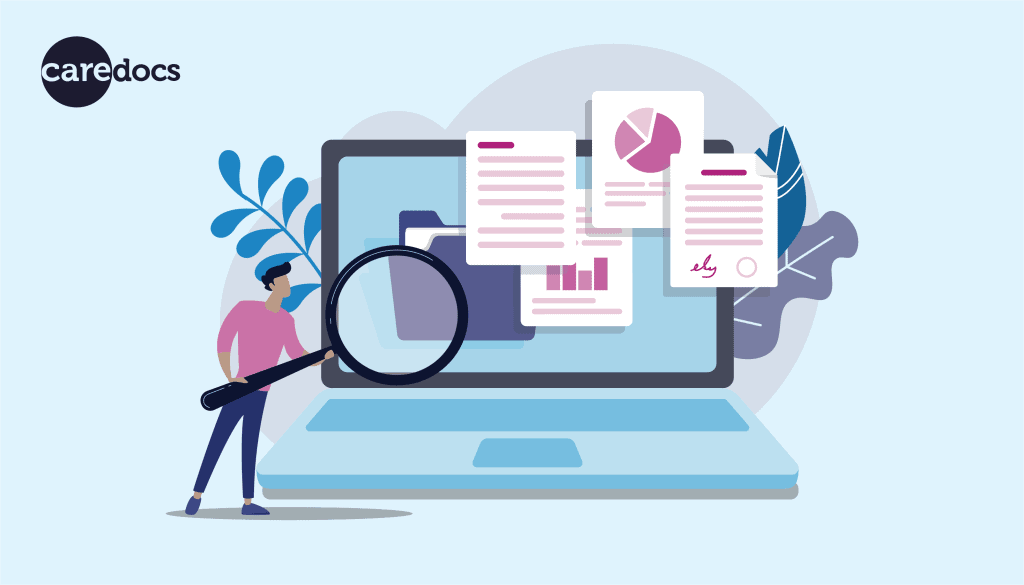
Using technology to help with point of care recording
Integrating technology into a care business can support management, staff and residents in a huge variety of ways. Digital care management systems are one form of technology which have been around since the 2000s, originally designed to make the recording process more efficient and reduce your daily workload by cutting down the number of steps needed to get from point A to point B. Care management software has evolved massively since first coming onto the scene, with new digital solutions and benefits being added regularly. Electronic record keeping and point of care recording are just two examples of innovation made possible by tech advancements that have revolutionised the way care services are provided.
Care management software has made it easier and faster to complete the majority of all care tasks, such as care planning, logging chart entries and reviewing historic documents. More specifically for care recording, paper records can be entirely replaced by digital records. Paper records have many limitations in a busy care environment and require more work to manage. For example, paper notes are generally written at the point of care and are used to create official records at a time later in the day.
During the space between providing care and care recording it’s possible the notes become damaged or misplaced during a long shift, potentially causing harm to the resident if crucial information is forgotten. It’s also possible to misinterpret notes that have been rushed or written in shorthand to save time. Most of us already carry phones with us in our pockets, so if you have a mobile device at hand which is capable of sending your care records directly to a digital system, you can record the service on the spot and save a lot of precious time.
Further disadvantages to using paper become evident after the initial recording process. It’s more difficult to make small edits, like fixing typos, after the record has been completed. Scribbling out mistakes, writing in the margins or using correction fluids can make the document look messy and sometimes unprofessional which could raise concerns in an inspection. You may even decide to re-write the record but this would lead to more inefficiency in the workplace.
Once a paper record has been completed, it’s then ready to be filed away and stored. Physical records take up a lot of precious space and can take time to put away in the proper folder and find again. In comparison, digital records are instantly saved on the system, taking up no physical space and can be located easily in only a handful of clicks.
Many modern smart phones and tablets now have speech-to-text functionality, enabling you to transcribe spoken word into text on the screen. It’s used as a faster alternative to handwriting and typing and the benefits are starting to gain attention in care settings because of its compatibility with care management software. Using speech to record care puts a strong focus on transparency and communication – helping information flow easier. You won’t have to keep pausing your conversations to allow time for writing and because residents can hear exactly what is being recorded, they can inform you if certain details could be improved. Speech-to-text isn’t perfect, so you will still need to read through it and fix any errors, the same as you would if you wrote it yourself.
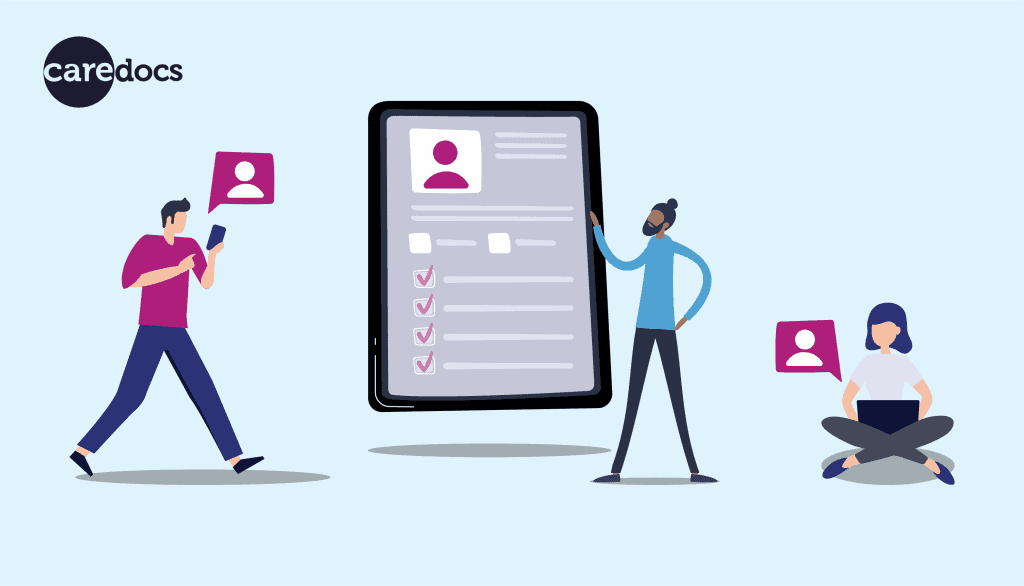
Top tips for point of care recording
Before rolling out a new point of care recording system across the business, ensure each staff member has access to a dedicated smart phone or tablet. Not only will this limit confusion over whose turn it is to use a device but it will also help you keep track of who is responsible for it if it goes missing. Keeping a log of who has access to the device between a certain time will make it easier to identify where it could be.
Consider providing company-issued smart phones and tablets instead of relying on personal devices. Although personal devices are convenient, cost-effective and do the same job, they also offer extra distractions. A resident might not feel like their time is being valued if their service is interrupted by a personal phone call or text message, drawing attention away from the task at hand. If required, company-issued devices can be locked in Kiosk Mode to avoid personal use, so only certain apps such as care management software can be used. Devices supplied by the business are also usually insured, come with expert support and can be repaired without much fuss.
It’s worth remembering that if you ask your staff to use personal devices for point of care recording, if that device breaks or is stolen, then that staff member will be without the necessary equipment to do their job. You should also be aware that not all personal devices will meet the minimum required specifications to use care software due to outdated technology.
Provide training on how to use the devices and the point of care recording system. Lack of training and low tech confidence is a big contributor to why many care businesses return to using paper systems.
Leave your electronic devices charging when not in use. Although most devices will be able to run all day, an empty battery will cause you to lose time trying to source another device, which someone else might have needed.
Make sure you have all the information you need before finishing a record. You don’t want to add to it later otherwise it becomes less efficient and potentially less accurate.
Password protect any devices that have access to your system. In the event that a device is misplaced or stolen, you will have peace of mind that your systems and confidential information will be secure. An extra security feature that is available when using a care management system like CareDocs is the ability to choose which IP addresses your staff have to be connected to (whitelisted) in order to use to the software remotely. This means if a device is used from an unapproved location, then even with a password, the user will be denied access. CareDocs also gives you the ability to exclude certain users from the list of approved IP addresses.
Whatever records system you decide to use, it must comply with GDPR. It needs to be secure and set-up so each staff member only sees information that is necessary for them to do their job. Most reputable professional care management systems are encrypted and will support you with setting up security permissions.
To learn more about CareDocs and our point of care recording services, please book a free demo with one of our friendly Business Development Managers, email sales@caredocs.co.uk or call 0330 056 3333 (opt. 2).
If you require assistance with the CareDocs software, we’re standing by to provide support. Email support@caredocs.co.uk or call us on 0330 056 3333 (opt. 1).
Download your free ebook!
Don’t forget to grab your copy of our free Point of Care Recording ebook…
Share this article
Author
Joe Webber
Search
Recent articles
- CareDocs Partners with the Professional Record Standards Body (PRSB) to Support Care Standards Fit for the Future of Digital Care January 30, 2024
- CareDocs Joins the Care Software Providers Association (CASPA), an Independent, Not for Profit Association, Representing Software in the Care Industry January 19, 2024
- CareDocs partners with Bristol Waste to tackle digital poverty January 10, 2024
Recent comments
- 1.2. Assess use of care plans in applying person-centered values - CIPD Writers on What is person centred care planning and why is it important?
- Call tracking tips for care home marketers - Chester Times on The importance of effective communication in care
- Why is effective communication important for positive relationships with individuals in care? - Building-Craft on The importance of effective communication in care










